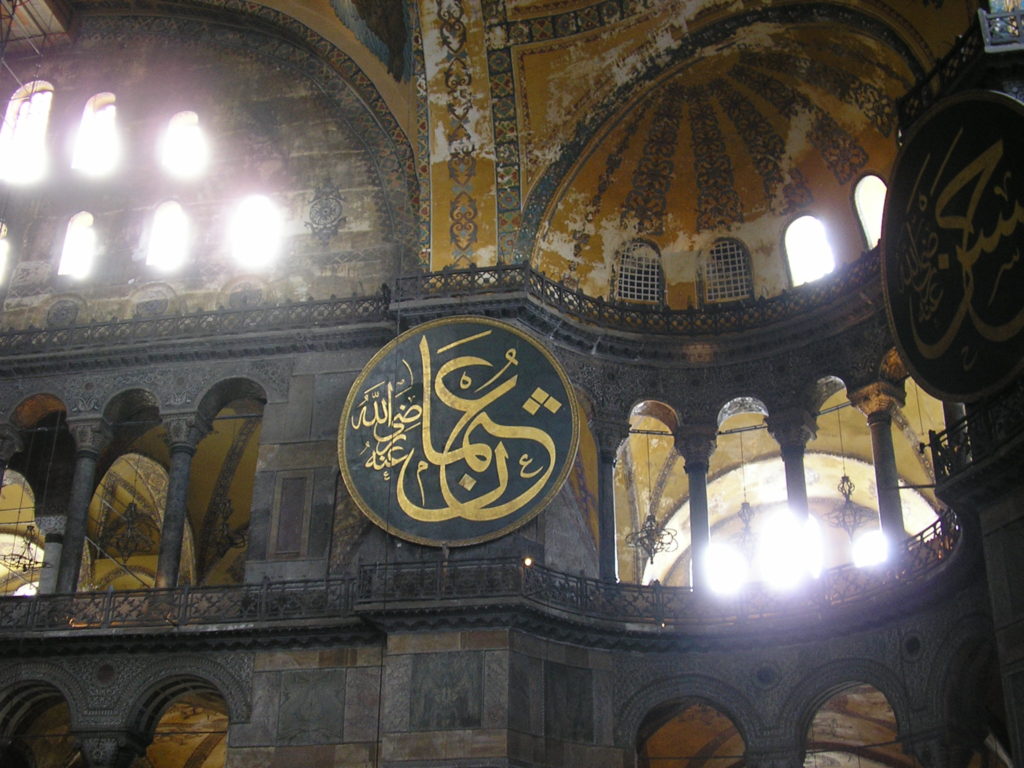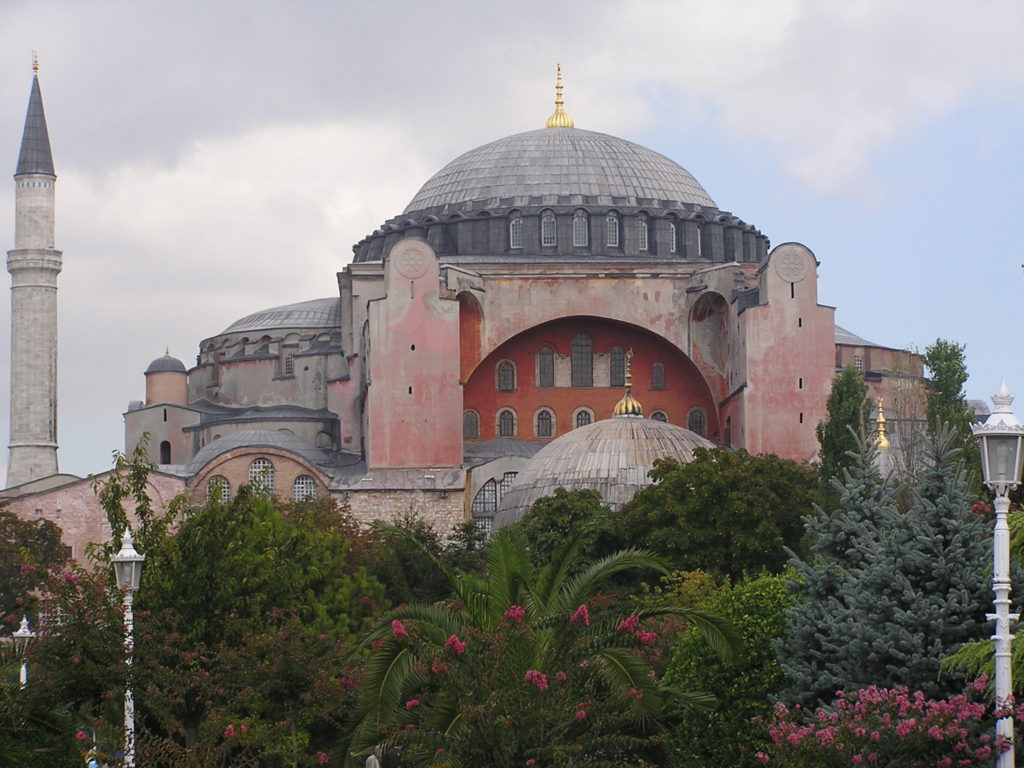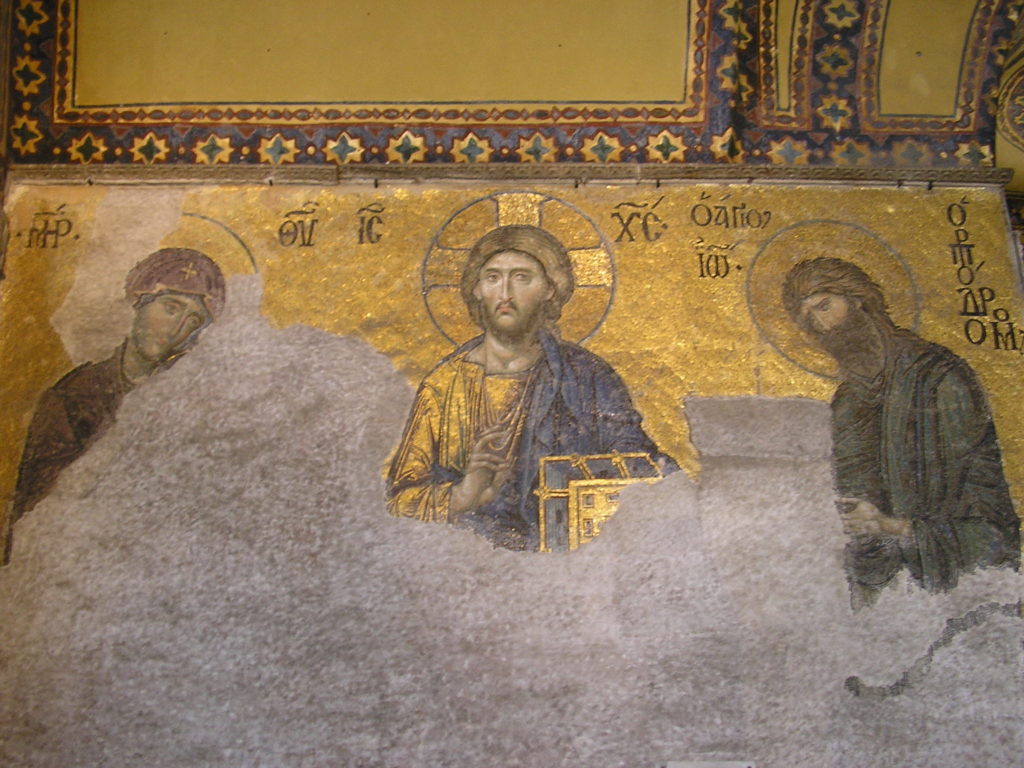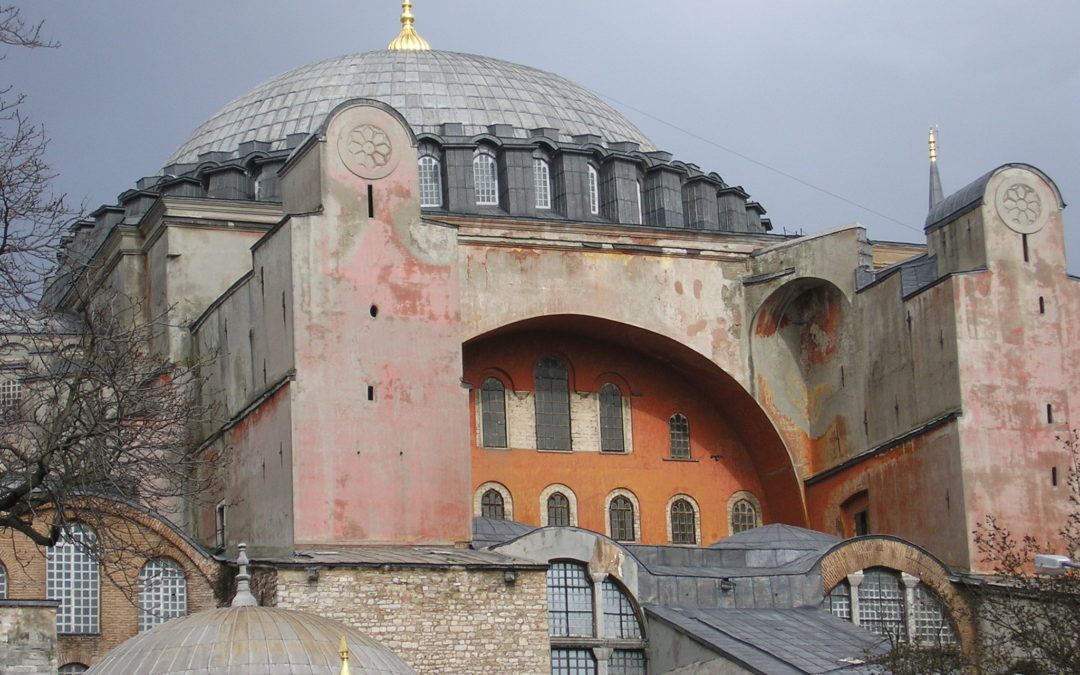The Hagia Sophia is making the news these days because the Turkish president is changing the status of the great building from a world museum and UNESCO World Heritage site…to a mosque. But what is the Hagia Sophia? It’s perhaps a shame that so few understand the incredible role the Hagia Sophia basilica played in world history.
The medieval era marks one of only four major eras in human history. Historians generally classify the medieval era as lasting from 500 to 1500 C.E. Well, the Hagia Sophia fulfilled its historical role from 537 to 1453 – the exact time frame of the medieval era. Perhaps no other building exists in the Western Hemisphere that serves as a better embodiment of the medieval era than the Hagia Sophia.

OLYMPUS DIGITAL CAMERA
Many people in the world today view the St. Peter’s Basilica in Vatican City as the center of Christendom. And yet, St. Peter’s Basilica is a scant 394 years old. By comparison, Hagia Sophia is 1,483 years old. Go ahead a whistle if you’re impressed. Unlike many buildings of this vintage, the Church of Holy Wisdom, as it is alternatively called, is still fully functional.
Older than Islam, the Hagia Sophia basilica had been built as the monumental symbol of Christendom on earth. The bulky structure faces out to the world with a hue of faded red paint, crowned by a purple-gray dome, and topped with a golden spike. Four minarets flank the building, two at the fore and two at the rear (these are more recent additions).

OLYMPUS DIGITAL CAMERA
Timeline of the Hagia Sophia:
532 – The original Hagia Sophia was destroyed during the Nika Riots
537 – The current architectural wonder is completed during the reign of Justinian and Theodora the Great
1204 – Converted to a Roman Catholic cathedral, after Western crusaders sack Constantinople
1261 – Returned to the Eastern Orthodox Church
1453 – Converted to a mosque after the fall of Constantinople to the Ottoman Turks
1507 – Construction of St. Peter’s Basilica begins in Italy to replace the Hagia Sophia
1616 – The Blue Mosque is built across from the Hagia Sophia in Istanbul
1626 – St. Peter’s Basilica is finally consecrated
1934 – Mustafa Kemal Ataturk, the father of modern Turkey, converts the Hagia Sophia to a museum
2020 – President Recep Ergodan, Turkey’s current leader, decreed the Hagia Sophia to be a mosque again
While Europe was slogging through a violent and regressive dark age, the Hagia Sophia rose above the city of Constantinople as a bulwark of civilization and a beacon of religious devotion that defined the era. The Hagia Sophia was the largest church in the world, with one of the largest enclosed spaces until modern times, and featuring architectural distinctions that redefined architecture.
I’ve been there. I’ve seen it. And the building is spellbinding. After passing through massive doorways once reserved for Roman emperors, you enter a cavernous space of gleaming marble, a forest of marble pillars, and a haze of foggy sunlight peeking through the windows. One gazes up into the underside of the great dome and falls dizzy with wonder.
In my opinion, the Western world doesn’t give enough credit to the Greek-speaking Byzantine Empire that built the Hagia Sophia. Clearly, we took for granted that such an important site wouldn’t be nationalized at the snap of one man’s fingers. And since human depictions are not allowed within mosques, the stunning historical mosaics that adorn the walls will likely be covered up with plaster or some other means. This is equivalent to covering up the ceilings of the Sistine Chapel.

OLYMPUS DIGITAL CAMERA
The Hagia Sophia should remain a museum. A museum is a higher calling since it preserves something about all human history, regardless of religion or nation or politics. It’s universal and inclusive. A museum belongs to all of us and enlightens us. If you suspect that perhaps you don’t know much about the Byzantine Empire, please explore. It’s fascinating. The Byzantines set the table for the modern world in ways you may not have suspected.
History matters. And we must never forget.
Douglas A. Burton is an author of historical fiction. His critically-acclaimed and award-winning novel, ’Far Away Bird’ follows the early life of Byzantine Empress Theodora. Doug has been on a mission to introduce the Byzantine Empire’s vital role in history and Empress Theodora’s vital contribution to women’s rights.

A Russian Tsar sent representatives to Rome and Constantinople to choose a Russian State religion. They were so impressed by the Hagia Sophia that Russia became Orthodox rather than Catholic. Thus another development further divided Russia from WEStern Europe which marked the future of western history.
Douglas you have been bitten by the same bug as me! I was a high school history teacher and never got to tell of this marvelous entity.
Keep up your great work!
We toured that gorgeous building in 2005. It will be a sad day when that is no longer a museum to history!
Douglas, Herhaba! I lived in Turkey for several years in the 1950’s, learned a bit of the language, loved the people and the food. (My Dad was career USAF, training the then well regarded Turkish military).
My wife & I have been back to Turkey a number of times, have traveled extensively, and have always been awed by Hagia Sophia, one of the great buildings from antiquity. (Hopefully, the more educated Turks will still be able to save democracy from Erdogan.)Very much looking forward to reading vol.1 of your bio of Empress Theodora. Please keep up your fine work & articles
Thank you for reaching out! I have been to Turkey and absolutely loved it. The Turkish people were very warm and welcoming and the of Istanbul, itself, just a magical place, especially at night. Let me know what you think about my novel on Empress Theodora. A lot of heart and soul went into the writing…! And, yes, hopefully, when cooler heads prevail, the Hagia Sophia will return to a museum.